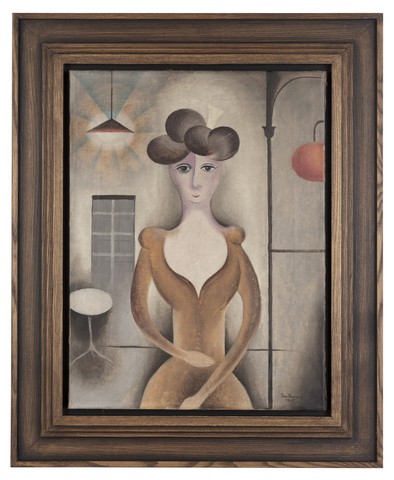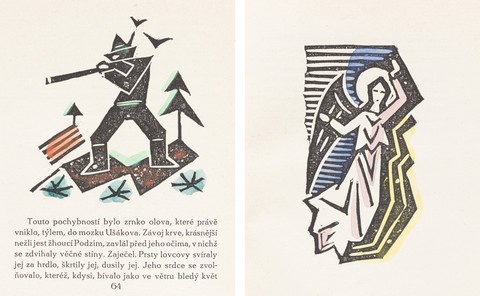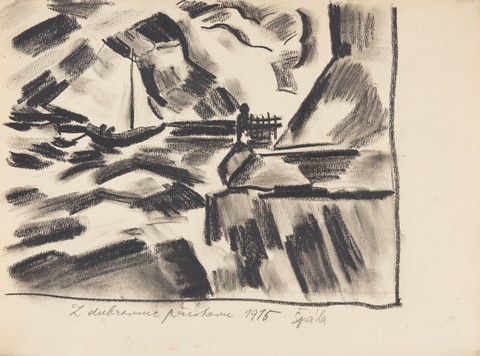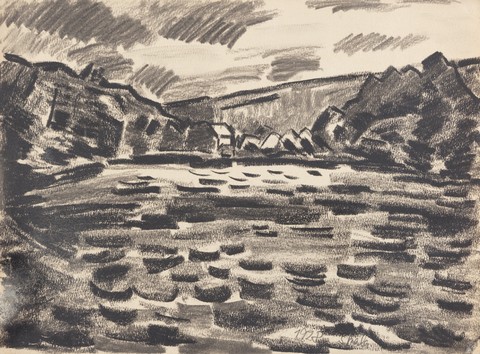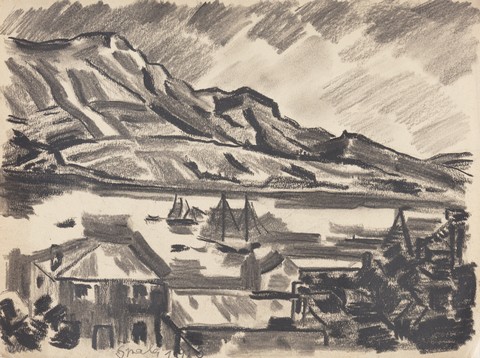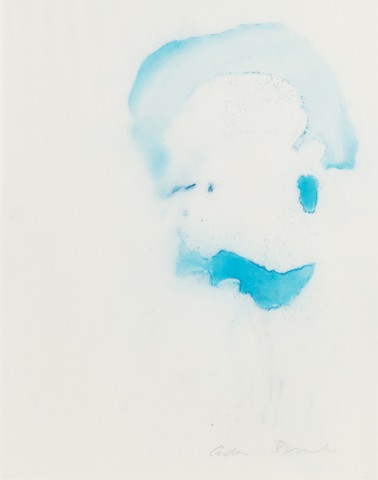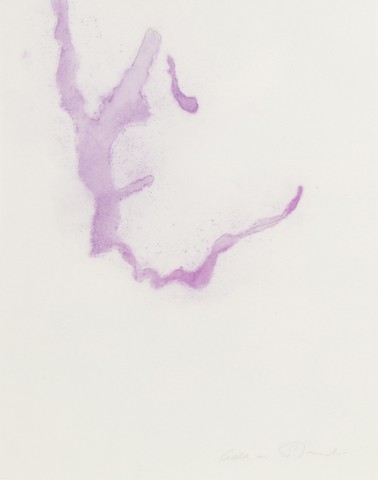‹ BACK
<<
>>
From the opinion of Rei Michalová, PhD. The painting under review, "The Courtesan", is an author's unquestionable, collector's exclusive, extremely delicate, civil in its subject and yet deeply poetic, ingeniously using artistic abbreviations, work of Jan Zrzavý, one of the most outstanding figures of European art of the twentieth century. Jan Zrzavý significantly influenced the development of our modern culture with his authentic creative imagination, in which he linked the Czech line of spiritual lyricism with European modernism. Very soon he found his own way of expression, which mirrors phenomenal reality indirectly, in elaborate signs and symbols. Beneath the veil of seemingly factual form, an intimate tension is played out, evident even under the vault of balance and fulfilment, peace and duration, revealing a kind of transposition to metaphor and parable. Landscape motifs, postures and gestures of figures, hints of architecture, mysterious mountains and flowers, forms and relationships of things – everything becomes a symbol of the artist's thoughts and experiences. The presented painting "The Courtesan" by Jan Zrzavý belongs to the artist's works of distinctive artistic qualities and multiple publicity, works of undisputed gallery value that are rarely found on the art market. It can be ranked alongside works such as "Lady with Fur" (1915, NG Prague), "Lady with Veil" (1915, NG Prague), "Woman at the Opera" (1915, NG Prague), "Portrayal of Mrs. D. " (1917, private collection), "Lady in a Lodge" (1918, NG Praha) and "Weeping Woman (Widow)" (1918, NG Praha), which resulted in the painter's membership in the Tvrdošíjní group and which were among those that most attracted the attention of the rising Devětsil generation, who "put Jan Zrzavý's name on their shield" (along with the names of Rudolf Kremlicka and Josef Čapek). All of these works by Zrzavý are united by the fact that they are iconic works of the author, as well as by their motivational focus on women in the broader spectrum of their social determination. This new "civilized poetry" counterbalanced the painter's previous emotionally strained period; it was also an undeniable response to the naked humanity of the war days. From 1913 onwards, when Josef Čapek thought about his subjects, he was, in his own words, driven by a special preoccupation. "The task was to penetrate this banality as deeply as possible from the painter's point of view and to achieve a feeling similar to the one we sometimes have over photographs, over Cézanne's and Picasso's figures: that people, even if it is possible to smell and feel them, are a bit like apparitions" (J. Čapek). This is exactly the feeling the viewer has when contemplating the painting under consideration by Jan Zrzavý, " The Courtesan". Here, the painter, in a brilliantly modern elemental, post-cubist form, has depicted a concrete being into which he has imprinted its fate. In 1915-1918 he was attracted to specific women, whom he observed especially in the vicinity of Hradčany and Nový Svět. For the homosexually oriented Zrzavý, the world of women had a special appeal. While in "The Lady with a Veil" (1915, NG Praha) he captured the seclusion of Miss Jarošová, with whom he stayed in Loretánská Street, "an old maid, terribly poor and destitute" (J. Z.), in " The Courtesan" he portrayed with extraordinary artistic sensitivity and tenderness the unnamed woman, whose difficult lot in life is suggested by the gesture of her hands, the defiant neckline, and the red lantern (captured from the right half of the painting), announcing a public house. From a formal point of view, the painting " The Courtesan" is built on the perfect interplay of precisely guided lines, depicting abstracted, "purified" shapes, and the neoptically felt colour, which is the carrier of the emotional atmosphere of the painting and a mirror of the artist's psychological state. What is extremely suggestive and typical for Zrzavý is the pictorial light that the colour emits, which gives the depicted scene the aforementioned character of revelation. In a letter dated 29 September 1915, Bohumil Kubišta urged Jan Zrzavý: "It is very good that you associate with the Čapeks, you can only gain by it." Zrzavý was lucky enough not to have had to enlist during the First World War. Although he was exposed to existential difficulties, he was able to stay in Prague. The painting "The Courtesan", one of his most important works from the First World War, substantially illustrates his entire artistic profile. During the first years of the war, Zrzavý was able to correspond about his intentions indirectly with Bohumil Kubišta, who served in the Austro-Hungarian army in Pula. Kubišta admired Zrzavý's paintings at the time. The painting "The Courtesan" tells a lot about his friendship with Josef Čapek: Zrzavý gravitated towards motifs from urban life, even dealing with light women, whom he occasionally depicted uncovered. He had reached the reverse plane of his work, dealing briefly, but significantly, with sensuality, in contrast to the previous inflamed spirituality of his earlier paintings. The Courtesan‘s painting is located on the borderline between sensuality and spirituality, both areas intertwined in it, Zrzavý conceived of the woman, located in an urban interior, equipped with a lamp at the ceiling, emitting crystalline light, and a round table below her, as a modern Madonna, as an unattainable ideal, which he could dream of, which he could admire, but remained unattainable for him. The immensely carefully painted painting, in which a room, bordered on the right by a thin column and a red lantern, opens up around a central figure in a brown suit with distinctive waves of hair and a nose outlined in blue, is so firmly in its time, when similar motifs were common in German Expressionism, but it also points to the future: it concerns the inner span of all Zrzavý's subsequent work, moving between sensuality and spirituality. Zrzavý apparently did not include The Courtesan in any exhibitions in his time - at least according to the surviving exhibition catalogues - but most of the artists who wrote about her from his studio (e.g. Johannes Urzidil) knew about her. For admirers of Jan Zrzavý, this is a major discovery: they can finally get a complete picture of Zrzavý's wartime work and get a closer look at the sensual side of his artistic thinking. Zrzavý has stripped woman of everything ephemeral and brought her into the realm of the timeless. He showed her in a form that was removed from the given time and space. ... It is a work of extraordinary artistic value, a substantial discovery, a unifying knowledge of Zrzavý's work. Exhibited at Collective exhibition of Jan Zrzavý, Work from 1905-1940, Municipal House, Prague, March-April 1940, cat. no. 51. Founders of Modern Czech Art, House of Art, Brno, 1957, under the title Likeness of a Lady, A Retrospective of Jan Zrzavý's Work 1907-1962, 1963, Mánes, 31 January-14 April 1963, cat. no. 68. Retrospective Jan Zrzavý Work 1907-1962 (reprise), House of the Lords of Kunštát in Brno, April-May 1963, cat. no. 51. Retrospective Jan Zrzavý Work 1907-1962 (reprise), Slovak National Gallery in Bratislava (from 9 June 1963). Published at František Dvořák, Jan Zrzavý, Publishing House of Czechoslovak Artists, Prague 1965, fig. 19. Miroslav Lamač, Jan Zrzavý, Odeon 1980, fig. 59; Miroslav Lamač, Osma and the Group of Visual Artists, Odeon, Prague, 1988, fig. 552, p. 486. Provenance The painting comes from a private collection, it was acquired from the estate of an important Brno art collector JUDr. Josef Slezák. JUDr. Josef Slezák (1888-1949) was one of Brno's most important art collectors and an unmissable personality of Brno's interwar cultural life. He was the last president of the Moravian Bar Association, co-founder of the Friends of Art Committee of the Brno Union of Visual Artists (1933), which brought together other important Brno personalities. JUDr. Josef Slezák was the founder of the Association of Moravian-Silesian Artists in Brno (1938). From the opinion of PhDr. Marie Dohnalová: In the development of Czech modern painting, Jan Zrzavý represents a solitary personality of extraordinary range and significance. From his early youth he was and remained an original artist. The poetic inner world of the painter was spared the twists and turns and the onslaughts of the developmental waves. In 1915, Zrzavý met the Čapek brothers, and together with Josef Čapek he then shared a common interest in social themes. Although the stylization of the works of both authors sometimes bears similar features, I would not speak of a direct fundamental influence, but rather of an intermingling of views that stemmed from the time and from a common approach to the social reality of the time, which reflected the crisis of the war years. The cubist-influenced stylization creates a deeply emotional work, imbued with an inner sadness and passive resignation, which is matched by a balanced, subtly graded colour palette. Miroslav Lamač in his monograph (p. 27) says the following about The Courtesan: Another socially identifiable figure is The Courtesan (1915), though only in name, which is only supported in the painting by the nocturnal setting and perhaps a gesture of the hands. The re-animated cubist elements bring this oil surprisingly close to Josef Čapek, whose formulation should take priority, however, cannot be decided. The pastel (Lady in a Lodge) appears to be a far more expressive work, overcoming the formal pedantry of The Courtesan towards a new expressiveness... A contemporary variant of The Courtesan's oil painting is the undated drawing Lady in a Lodge with a Lornion (ink, paper, 20.1 x 16.4 cm, signed lower right: Jan Zrzavý), which is in a distinguished private collection. The colour pastel Lady in a box (originally in the collection of MUDr. A. Starý, Prague, now the National Gallery in Prague 1918), which Karel Teige dates to 1916 ( ) in a monograph published in Aventino in 1923, can be considered a continuation of the subject. The subject and the compositional scheme are identical, the hairstyle of both women is also the same, but in comparison to the serious and somewhat uptight The Courtesan, The Lady in the Lodge is a more erotically expressive work due to its strong colouring, exposed breasts and other details. The oil painting The Courtesan (1915) is a painting that returns to the scene again after many years. As the original collection of the relatively soon-deceased JUDr. Josef Slezák changed hands over time, this undoubtedly interesting and high-quality painting by Zrzavý has escaped attention. Today, the rediscovery of a previously exhibited work by an artist of such importance as Jan Zrzavý can be described as an absolutely exceptional event. Moreover, when it is a painting of unquestionable authorship, authenticity and with a history of origin. A selection of literature on the painting Johannes URZIDIL, Jan Zrzavý, An Attempt to Analyse His Work. Veraikon VI, 1920, pp. 148-160. Johannes URZIDIL – Miloš MINAŘÍK. Life with Czech painters: mutual correspondence with Jan Zrzavý: memories – texts – documents. Horní Planá: Fraktál, 2003, pp. 37-48 and 189 ad. Karel ŠOUREK et al. UB, Jan Zrzavý, collective exhibition. Paintings and drawings from 1905-1940, Municipal House Prague, 6-30 March 1940. Luboš HLAVÁČEK, Marginalia on the work of Jan Zrzavý. Umění: journal of the Institute of Art History of the Academy of Sciences of the Czech Republic.1963, 11(5), pp. 370-391. František DVOŘÁK, Jan Zrzavý, Publishing House of Czechoslovak Artists, Prague 1965. Eva REITHAROVÁ, The Landscape Motif in Czech Painting, Umění, Prague 1966, no. 6, pp. 569-595. Miroslav LAMAČ, Jan Zrzavý [Fig. monograph]. Prague: Odeon, 1980, p. 27, b/w reproduction no. p. 59, p. 115, inventory p. 218. Miroslav LAMAČ, Osma and the Group of Artists 1907-1917, Prague, Odeon, 1988, p. 486, inventory of illustrations p. 525, b/w reproduction no. 552.
Zrzavý Jan 1890–1977
The Courtesan, 1915
The Courtesan, 1915, oil on canvas, frame, 54,5 x 41 cm, signed. PD Jan Zrzavý 1915, a paper label from the exhibition at the Art Gallery on the reverse, paper label with a description of the work, owner's stamp JUDr. Josef Slezák, original frame attached. Attached expert opinions from 2022 by PhDr. Karel Srp, PhDr. Rey Michalová and PhDr. Marie Dohnalová.From the opinion of Rei Michalová, PhD. The painting under review, "The Courtesan", is an author's unquestionable, collector's exclusive, extremely delicate, civil in its subject and yet deeply poetic, ingeniously using artistic abbreviations, work of Jan Zrzavý, one of the most outstanding figures of European art of the twentieth century. Jan Zrzavý significantly influenced the development of our modern culture with his authentic creative imagination, in which he linked the Czech line of spiritual lyricism with European modernism. Very soon he found his own way of expression, which mirrors phenomenal reality indirectly, in elaborate signs and symbols. Beneath the veil of seemingly factual form, an intimate tension is played out, evident even under the vault of balance and fulfilment, peace and duration, revealing a kind of transposition to metaphor and parable. Landscape motifs, postures and gestures of figures, hints of architecture, mysterious mountains and flowers, forms and relationships of things – everything becomes a symbol of the artist's thoughts and experiences. The presented painting "The Courtesan" by Jan Zrzavý belongs to the artist's works of distinctive artistic qualities and multiple publicity, works of undisputed gallery value that are rarely found on the art market. It can be ranked alongside works such as "Lady with Fur" (1915, NG Prague), "Lady with Veil" (1915, NG Prague), "Woman at the Opera" (1915, NG Prague), "Portrayal of Mrs. D. " (1917, private collection), "Lady in a Lodge" (1918, NG Praha) and "Weeping Woman (Widow)" (1918, NG Praha), which resulted in the painter's membership in the Tvrdošíjní group and which were among those that most attracted the attention of the rising Devětsil generation, who "put Jan Zrzavý's name on their shield" (along with the names of Rudolf Kremlicka and Josef Čapek). All of these works by Zrzavý are united by the fact that they are iconic works of the author, as well as by their motivational focus on women in the broader spectrum of their social determination. This new "civilized poetry" counterbalanced the painter's previous emotionally strained period; it was also an undeniable response to the naked humanity of the war days. From 1913 onwards, when Josef Čapek thought about his subjects, he was, in his own words, driven by a special preoccupation. "The task was to penetrate this banality as deeply as possible from the painter's point of view and to achieve a feeling similar to the one we sometimes have over photographs, over Cézanne's and Picasso's figures: that people, even if it is possible to smell and feel them, are a bit like apparitions" (J. Čapek). This is exactly the feeling the viewer has when contemplating the painting under consideration by Jan Zrzavý, " The Courtesan". Here, the painter, in a brilliantly modern elemental, post-cubist form, has depicted a concrete being into which he has imprinted its fate. In 1915-1918 he was attracted to specific women, whom he observed especially in the vicinity of Hradčany and Nový Svět. For the homosexually oriented Zrzavý, the world of women had a special appeal. While in "The Lady with a Veil" (1915, NG Praha) he captured the seclusion of Miss Jarošová, with whom he stayed in Loretánská Street, "an old maid, terribly poor and destitute" (J. Z.), in " The Courtesan" he portrayed with extraordinary artistic sensitivity and tenderness the unnamed woman, whose difficult lot in life is suggested by the gesture of her hands, the defiant neckline, and the red lantern (captured from the right half of the painting), announcing a public house. From a formal point of view, the painting " The Courtesan" is built on the perfect interplay of precisely guided lines, depicting abstracted, "purified" shapes, and the neoptically felt colour, which is the carrier of the emotional atmosphere of the painting and a mirror of the artist's psychological state. What is extremely suggestive and typical for Zrzavý is the pictorial light that the colour emits, which gives the depicted scene the aforementioned character of revelation. In a letter dated 29 September 1915, Bohumil Kubišta urged Jan Zrzavý: "It is very good that you associate with the Čapeks, you can only gain by it." Zrzavý was lucky enough not to have had to enlist during the First World War. Although he was exposed to existential difficulties, he was able to stay in Prague. The painting "The Courtesan", one of his most important works from the First World War, substantially illustrates his entire artistic profile. During the first years of the war, Zrzavý was able to correspond about his intentions indirectly with Bohumil Kubišta, who served in the Austro-Hungarian army in Pula. Kubišta admired Zrzavý's paintings at the time. The painting "The Courtesan" tells a lot about his friendship with Josef Čapek: Zrzavý gravitated towards motifs from urban life, even dealing with light women, whom he occasionally depicted uncovered. He had reached the reverse plane of his work, dealing briefly, but significantly, with sensuality, in contrast to the previous inflamed spirituality of his earlier paintings. The Courtesan‘s painting is located on the borderline between sensuality and spirituality, both areas intertwined in it, Zrzavý conceived of the woman, located in an urban interior, equipped with a lamp at the ceiling, emitting crystalline light, and a round table below her, as a modern Madonna, as an unattainable ideal, which he could dream of, which he could admire, but remained unattainable for him. The immensely carefully painted painting, in which a room, bordered on the right by a thin column and a red lantern, opens up around a central figure in a brown suit with distinctive waves of hair and a nose outlined in blue, is so firmly in its time, when similar motifs were common in German Expressionism, but it also points to the future: it concerns the inner span of all Zrzavý's subsequent work, moving between sensuality and spirituality. Zrzavý apparently did not include The Courtesan in any exhibitions in his time - at least according to the surviving exhibition catalogues - but most of the artists who wrote about her from his studio (e.g. Johannes Urzidil) knew about her. For admirers of Jan Zrzavý, this is a major discovery: they can finally get a complete picture of Zrzavý's wartime work and get a closer look at the sensual side of his artistic thinking. Zrzavý has stripped woman of everything ephemeral and brought her into the realm of the timeless. He showed her in a form that was removed from the given time and space. ... It is a work of extraordinary artistic value, a substantial discovery, a unifying knowledge of Zrzavý's work. Exhibited at Collective exhibition of Jan Zrzavý, Work from 1905-1940, Municipal House, Prague, March-April 1940, cat. no. 51. Founders of Modern Czech Art, House of Art, Brno, 1957, under the title Likeness of a Lady, A Retrospective of Jan Zrzavý's Work 1907-1962, 1963, Mánes, 31 January-14 April 1963, cat. no. 68. Retrospective Jan Zrzavý Work 1907-1962 (reprise), House of the Lords of Kunštát in Brno, April-May 1963, cat. no. 51. Retrospective Jan Zrzavý Work 1907-1962 (reprise), Slovak National Gallery in Bratislava (from 9 June 1963). Published at František Dvořák, Jan Zrzavý, Publishing House of Czechoslovak Artists, Prague 1965, fig. 19. Miroslav Lamač, Jan Zrzavý, Odeon 1980, fig. 59; Miroslav Lamač, Osma and the Group of Visual Artists, Odeon, Prague, 1988, fig. 552, p. 486. Provenance The painting comes from a private collection, it was acquired from the estate of an important Brno art collector JUDr. Josef Slezák. JUDr. Josef Slezák (1888-1949) was one of Brno's most important art collectors and an unmissable personality of Brno's interwar cultural life. He was the last president of the Moravian Bar Association, co-founder of the Friends of Art Committee of the Brno Union of Visual Artists (1933), which brought together other important Brno personalities. JUDr. Josef Slezák was the founder of the Association of Moravian-Silesian Artists in Brno (1938). From the opinion of PhDr. Marie Dohnalová: In the development of Czech modern painting, Jan Zrzavý represents a solitary personality of extraordinary range and significance. From his early youth he was and remained an original artist. The poetic inner world of the painter was spared the twists and turns and the onslaughts of the developmental waves. In 1915, Zrzavý met the Čapek brothers, and together with Josef Čapek he then shared a common interest in social themes. Although the stylization of the works of both authors sometimes bears similar features, I would not speak of a direct fundamental influence, but rather of an intermingling of views that stemmed from the time and from a common approach to the social reality of the time, which reflected the crisis of the war years. The cubist-influenced stylization creates a deeply emotional work, imbued with an inner sadness and passive resignation, which is matched by a balanced, subtly graded colour palette. Miroslav Lamač in his monograph (p. 27) says the following about The Courtesan: Another socially identifiable figure is The Courtesan (1915), though only in name, which is only supported in the painting by the nocturnal setting and perhaps a gesture of the hands. The re-animated cubist elements bring this oil surprisingly close to Josef Čapek, whose formulation should take priority, however, cannot be decided. The pastel (Lady in a Lodge) appears to be a far more expressive work, overcoming the formal pedantry of The Courtesan towards a new expressiveness... A contemporary variant of The Courtesan's oil painting is the undated drawing Lady in a Lodge with a Lornion (ink, paper, 20.1 x 16.4 cm, signed lower right: Jan Zrzavý), which is in a distinguished private collection. The colour pastel Lady in a box (originally in the collection of MUDr. A. Starý, Prague, now the National Gallery in Prague 1918), which Karel Teige dates to 1916 ( ) in a monograph published in Aventino in 1923, can be considered a continuation of the subject. The subject and the compositional scheme are identical, the hairstyle of both women is also the same, but in comparison to the serious and somewhat uptight The Courtesan, The Lady in the Lodge is a more erotically expressive work due to its strong colouring, exposed breasts and other details. The oil painting The Courtesan (1915) is a painting that returns to the scene again after many years. As the original collection of the relatively soon-deceased JUDr. Josef Slezák changed hands over time, this undoubtedly interesting and high-quality painting by Zrzavý has escaped attention. Today, the rediscovery of a previously exhibited work by an artist of such importance as Jan Zrzavý can be described as an absolutely exceptional event. Moreover, when it is a painting of unquestionable authorship, authenticity and with a history of origin. A selection of literature on the painting Johannes URZIDIL, Jan Zrzavý, An Attempt to Analyse His Work. Veraikon VI, 1920, pp. 148-160. Johannes URZIDIL – Miloš MINAŘÍK. Life with Czech painters: mutual correspondence with Jan Zrzavý: memories – texts – documents. Horní Planá: Fraktál, 2003, pp. 37-48 and 189 ad. Karel ŠOUREK et al. UB, Jan Zrzavý, collective exhibition. Paintings and drawings from 1905-1940, Municipal House Prague, 6-30 March 1940. Luboš HLAVÁČEK, Marginalia on the work of Jan Zrzavý. Umění: journal of the Institute of Art History of the Academy of Sciences of the Czech Republic.1963, 11(5), pp. 370-391. František DVOŘÁK, Jan Zrzavý, Publishing House of Czechoslovak Artists, Prague 1965. Eva REITHAROVÁ, The Landscape Motif in Czech Painting, Umění, Prague 1966, no. 6, pp. 569-595. Miroslav LAMAČ, Jan Zrzavý [Fig. monograph]. Prague: Odeon, 1980, p. 27, b/w reproduction no. p. 59, p. 115, inventory p. 218. Miroslav LAMAČ, Osma and the Group of Artists 1907-1917, Prague, Odeon, 1988, p. 486, inventory of illustrations p. 525, b/w reproduction no. 552.
28
auction 62
starting price 8 000 000 CZK € 326 264
hammer price 13 600 000 CZK
starting price 8 000 000 CZK € 326 264
hammer price 13 600 000 CZK
Other items
cat. n.29
auction: 62
8 000 CZK / 326 €
starting price:
31 000 CZK
hammer price:
cat. n.30
auction: 62
30 000 CZK / 1 223 €
starting price:
cat. n.33
auction: 62
30 000 CZK / 1 223 €
starting price:
cat. n.34
auction: 62
30 000 CZK / 1 223 €
starting price:




